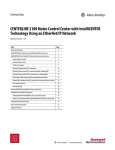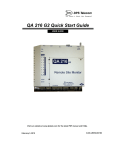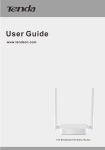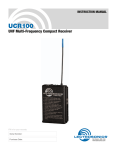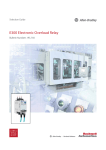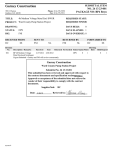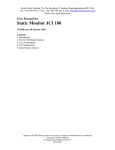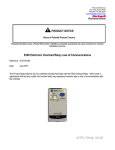Download CENTERLINE 1500 Motor Control Center with
Transcript
Technical Data CENTERLINE 1500 Motor Control Center with IntelliCENTER Technology Using an EtherNet/IP Network Catalog Numbers 1500, 1512A, 1512B, 1560E, 1562, 1591 Topic Page About This Publication 2 IntelliCENTER Motor Control Center with Ethernet/IP Network Overview 3 IntelliCENTER MCC with EtherNet/IP System Architecture and Connections 4 Industrial Ethernet Switch 4 Industrial Ethernet Cable 6 24V DC Power Supply 7 EtherNet/IP Network and 24V DC Connections 8 EtherNet/IP Network and 24V DC Connections Within an MCC 8 EtherNet/IP Network and 24V DC Connections Across an MCC Lineup 9 Plant-wide Connections 11 Network Topology 12 New IntelliCENTER EtherNet/IP MCC Lineup Commissioning 14 MCC Lineup Installation 14 EtherNet/IP and 24V DC Connections 14 IntelliCENTER EtherNet/IP MCC Expansion 14 Adding Sections to an Existing Lineup 14 Rearranging Sections Within an Existing Lineup 16 IntelliCENTER EtherNet/IP Software 17 Commissioning Checklist 17 Additional Resources 20 CENTERLINE 1500 Motor Control Center with EtherNet/IP Network About This Publication This document is for engineers or technicians directly involved in the installation, connection, commissioning, energizing, and maintenance of the CENTERLINE® 1500 Motor Control Center (MCC) with EtherNet/IP network. See Commissioning Checklist before applying power to the MCC. This document provides the following information about CENTERLINE 1500 MCCs with EtherNet/IP network: • System architecture • Factory installed components • EtherNet/IP network connections • 24V DC power connections commissioning • Expansion of the existing lineup • Integration of the EtherNet/IP network into your plant-wide network This table defines abbreviations that are used in this manual. Table 1 - Terminology 2 Abbreviation Full Term Definition MCC Medium Voltage Motor Control Center An assembly of one or more enclosed sections that contains motor control units, have a common power bus, and are connected using an EtherNet/IP network. IMC Intelligent Motor Control Motor Control and Protection devices that can connect to a communication network. CPwE Converged Plantwide Ethernet Rockwell Automation and Cisco initiative to standardize Ethernet network implementation across the manufacturing and enterprise networks. REP Resilient Ethernet Protocol Redundant network topology/feature in the Stratix 5700™ switch. Rockwell Automation Publication 1500-TD001A-EN-P - October 2015 CENTERLINE 1500 Motor Control Center with EtherNet/IP Network IntelliCENTER Motor Control Center with Ethernet/IP Network Overview The IntelliCENTER® EtherNet/IP MCC couples the reliability of the CENTERLINE 1500 MCC with robust EtherNet/IP network, Intelligent Motor Control (IMC) devices, and intuitive IntelliCENTER software to deliver an effective and integrated motor control solution. The IntelliCENTER EtherNet/IP MCC is an assembly of one or more enclosed vertical sections powered by a common power bus. Each section can typically contain one or two intelligent motor control devices. IMC devices available within the MCC include: • Bulletin 857 or 865 motor/feeder protection relay • E300™ electronic overload relay • E1 Plus™ electronic overload relay via EtherNet/IP side module • IntelliVAC™ control module via POINT I/O™ adapter (1734-AENT) • SMC™ Flex control module via PowerFlex® 20-COMM-E EtherNet/IP adapter • PowerMonitor™ 5000 device The MCC section has a 15.2 x 15.2 cm (6 x 6 in.) low voltage (LV) wireway across the top of the structure where the wiring connections are made. The LV wireway is an enforced option when the EtherNet/IP network method is selected with MCCs. The built-in horizontal wireway contains Ethernet cable routings and 24V DC power supply wiring, which could vary based on customer requests. Figure 1 - Example of a CENTERLINE 1500 MCC Lineup MV MV LV MV (LV) LV LV MV MV LV LV Incoming Line Unit (1591A) MV MV Two-High FVNR Controller (1512B) Two-High FVNR Controller (1512B) Rockwell Automation Publication 1500-TD001A-EN-P - October 2015 One-High FVNR Controller (1512A) 3 CENTERLINE 1500 Motor Control Center with EtherNet/IP Network The EtherNet/IP network is an industrial version of an Ethernet network. IntelliCENTER EtherNet/IP MCCs use the EtherNet/IP network to connect IMC devices in your application. The EtherNet/IP network provides one robust and reliable network solution for your entire factory from the front office to the MCC. The integrated EtherNet/IP network within your IntelliCENTER MCC is preconfigured, tested, and validated at the factory before shipment. The EtherNet/IP network integrates with current IT networks and lets you collect data to determine plant production, energy efficiency, and other metrics. The EtherNet/IP network can accommodate a vast number of nodes and has no specific maximum number of nodes like other fieldbus networks. The limit varies based on the number of connections the EtherNet/IP scanner can make within the controller application, and the network topology that is implemented. The number of connections that are used by each node varies. To estimate the number of connections a network uses, see the Advanced EtherNet/IP capacity tool that is embedded in the Integrated Architecture® Builder (IAB)(1) software http://raiseinstall.rockwellautomation.com/pst-lite.html. IntelliCENTER MCC with EtherNet/IP System Architecture and Connections The IntelliCENTER EtherNet/IP MCC system architecture is composed of a physical infrastructure that enables the appropriate network layout and topology for MCC applications. The physical infrastructure consists of industrial Ethernet switches, industrial Ethernet cables, ease of use integrated 24V DC power, and IMC device connections. This section focuses on these topics and describes how your MCC is shipped from the factory. Industrial Ethernet Switch The IntelliCENTER EtherNet/IP MCC is designed with Stratix 5700 Layer 2 managed switches. The Stratix 5700 switch is an industrial Ethernet switch that provides a range of advanced features. These advanced features let the IntelliCENTER EtherNet/IP MCC connect to the plant-wide EtherNet/IP network while providing a reliable and robust connection. The Stratix 5700 switch is factory-configured with user-defined static IP addresses and subnet masks upon ordering an MCC. All network connections are tested and validated during the system level test at the factory, before shipping. The standard IntelliCENTER EtherNet/IP MCC design contains a 10-port (Figure 2) or 20-port (Figure 3) Stratix 5700 switch. The type of Stratix™ switch that is installed in the MCC depends on the number of EtherNet/IP devices in the lineup and customer preference. Up to 8 IMC Devices The standard MCC design uses the 10-port Stratix 5700 switch when eight or fewer EtherNet/IP devices exist. Each 10-port Stratix 5700 switch has eight copper ports for IMC device-to-switch connections and two combination ports for switch-to-switch and switch-to-plant connections. Combination ports support fiber-optic or copper Ethernet connections. The standard MCC design uses copper connections for switch-to-switch connections. See the Industrial Ethernet Cable section for more information. Fiber-optic Ethernet cable can also be used for switch-to-switch connection. TIP (1) Bulletin 857 and 865 Relays are not available in IAB. 4 Rockwell Automation Publication 1500-TD001A-EN-P - October 2015 CENTERLINE 1500 Motor Control Center with EtherNet/IP Network Figure 2 - 10-port Stratix 5700 Switch Example Copper Ports (IMC device connections) Combination Ports (switch-to-switch connection) IMPORTANT 9 9 10 10 The 10-port Stratix 5700 switch that is shown is catalog number 1783-BMS10CL. For information on other Stratix 5700 switch catalog numbers, see the Stratix Managed Switches User Manual, publication 1783-UM007. 9…16 IMC Devices A Stratix 5700 20-port switch is used when 9…16 EtherNet/IP devices exist in the lineup. Each 20-port switch has 16 copper ports for IMC device-to-switch connections, two ports for switch-to-switch and switch-to-plant, and two ports for fiber-optic cable connections only. Figure 3 - 20-port Stratix 5700 Switch Example Copper Ports (IMC device connections) Copper Ports (switch-to-switch connection) IMPORTANT The 20-port Stratix 5700 switch that is shown is catalog number 1783-BMS20CL. For information on other Stratix 5700 switch catalog numbers, see the Stratix Managed Switches User Manual, publication 1783-UM007. More than 16 IMC Devices If more than 16 EtherNet/IP devices are required, additional Stratix 5700 switches must be added. Contact Rockwell Automation for more information. Rockwell Automation Publication 1500-TD001A-EN-P - October 2015 5 CENTERLINE 1500 Motor Control Center with EtherNet/IP Network Stratix 5700 Switch Mounting The standard mounting of the Stratix 5700 switch is in the LV section within the incoming line unit (Figure 4). Figure 4 - Stratix 5700 Switch Top Horizontal Wireway Mounting Example Low Voltage Wireway (not to scale) Stratix 5700 9 9 10 10 IMC MV (LV) LV IMC MV LV IMC MV Incoming Line Unit (1591A) LV MV IMC MV Two-High FVNR Controller (1512B) LV MV Two-High FVNR Controller (1512B) Additional Controllers... (15XX) Industrial Ethernet Cable Due to the high potential of electrical interference in an MCC, a proper industrial Ethernet communication cable is critical to provide a reliable and robust EtherNet/IP network. The EtherNet/IP network can technically use the same copper Ethernet cable that is used in an enterprise Ethernet network. But, to use that same enterprise rated Ethernet cable in an MCC is not a reliable and robust solution. Due to the potential of electrical noise in the MCC, the enterprise Ethernet rated cable can be exposed to electrical noise greater than its rated immunity. The IntelliCENTER EtherNet/IP MCC uses an exclusive 600V, UL Listed, Category 5e industrial EtherNet/IP cable to provide the noise immunity necessary in an MCC. With this 600V UL Listed industrial Ethernet cable, the EtherNet/IP network in the IntelliCENTER MCCs has been tested to the most rigorous standards for electrical noise immunity. These test results let Rockwell Automation deliver a robust, noise-immune EtherNet/IP network within the MCC: • Surge - Simulates lightning strike – ± 2 KV, 40 A surge that is repeatedly applied to the network cable – IEC 61000-4-5 • Fast Transient Burst - Simulates industrial noise – ± 1 KV high voltage burst applied to the network cable – IEC 61000-4-4 6 Rockwell Automation Publication 1500-TD001A-EN-P - October 2015 CENTERLINE 1500 Motor Control Center with EtherNet/IP Network • Conducted Immunity - Simulates radio frequency interference – 150 kHz…80 MHz interference that is applied to the network cable – IEC 61000-4-6 • Electrostatic Discharge Immunity - Simulates static discharge – ± 8 KV ESD event at 12 locations on the MCC and network cable – IEC 61000-4-2 Figure 5 - Industrial Ethernet Cable Table 2 shows the three speeds that the Category 5e industrial EtherNet/IP cable supports. The higher speed data rates transfer more data in a shorter period, which is vital for applications that require short response times. Table 2 - Category 5e Copper Cabling Speed Rating Data Speed 10BASE-T 10 Mb/s 100BASE-TX 100 Mb/s 1000BASE-T 1 Gb/s The standard Ethernet cable for switch-to-device connections is the 600V UL Listed copper Ethernet cable. However, fiber-optic Ethernet cable is sometimes required for switch-to-switch Ethernet connections in certain Ethernet topologies. The 600V UL Listed industrial Ethernet cable is also commonly used to connect the MCC to the plant-wide EtherNet/IP network. 24V DC Power Supply The Stratix 5700 10-port or 20-port switch is powered by a 24V DC power supply. There are a minimum of two 24V DC power supply units that power the Stratix 5700 switch for optimum redundancy. Both power supplies are powered from the MV bus through a control power transformer that is installed in the incoming line unit (Figure 6), or from a customersupplied power supply. A customer can use their own power supply, but it must be EtherNet/IP compatible as specified in ODVA requirements. ATTENTION: Non-compatible power supplies can damage the EtherNet/IP signal and components, or may not comply with local codes and inspection. Rockwell Automation Publication 1500-TD001A-EN-P - October 2015 7 CENTERLINE 1500 Motor Control Center with EtherNet/IP Network EtherNet/IP Network and 24V DC Connections This section is for engineers or technicians that are directly involved with commissioning the EtherNet/IP network and 24V DC connections in the MCC. As explained in the Network Topology section, the standard MCC design uses a linear/ star topology. In this design, the Stratix 5700 switch-to-switch connections use a linear topology, and the IMC device connections to the Stratix 5700 switches use a star topology. A ring/star topology is also available and is identical to the linear/star topology, but the Stratix 5700 switch-to-switch connections use a ring topology in place of the linear topology. These topologies are implemented throughout the MCC lineup by using an EtherNet/IP network. The EtherNet/IP network requires connections in each LV section that contains EtherNet/IP devices. EtherNet/IP Network and 24V DC Connections Within an MCC This section provides detailed instructions for commissioning EtherNet/IP network power connections within the MCCs. Because each motor controller within the lineup is shipped individually, it is impossible to pre-wire the switch-to-device Ethernet cables at the factory. On delivery, the incoming line unit contains a pre-wired Stratix 5700 switch, a 24V DC power supply, and a control power transformer. The Stratix 5700 switch is pre-connected with the required number of Ethernet cables, which are based on the number of devices in the lineup. Because the controllers are shipped individually, the Ethernet cables are coiled, labeled, and hang outside of the Incoming Line Unit. You can also have the cables placed in a box in the incoming line unit. Figure 6 - Incoming Line Unit and Controller Showing Bundled EtherNet/IP cables Low Voltage Wireway (not to scale) 5700 Stratix 9 9 10 10 Ethernet Cables IMC MV Power Supply LV IMC From Control Power Transformer MV LV Incoming Line Unit (1591A) 8 Two-High FVNR Controller (1512B) Rockwell Automation Publication 1500-TD001A-EN-P - October 2015 CENTERLINE 1500 Motor Control Center with EtherNet/IP Network EtherNet/IP Network and 24V DC Connections Across an MCC Lineup This section provides detailed instructions for the commissioning of the EtherNet/IP network across a full MCC lineup. As specified in EtherNet/IP Network and 24V DC Connections Within an MCC, when an MCC is shipped, each motor controller within the lineup is shipped individually, making it impossible to pre-wire switch-to-device Ethernet cable connections at the factory. After you receive the entire lineup, uncoil the Ethernet cables and route them through the top horizontal wireway to the Stratix switch in the incoming line unit. IMPORTANT The length of each Ethernet cable is predetermined for connections to IMC devices in the lineup. For example, controllers that are closely coupled to the incoming line unit have a shorter cable, and subsequent controllers will inversely have a longer cable. Figure 7 - Incoming Line Unit Showing the Control Wire Conduit Opening (Structure Code 24.1) LV (MV) Control Wire Conduit Opening MV Front View TIP Top View If there are more than eight IMC devices in the lineup, the Control Wire Conduit Opening can be altered to accommodate more Ethernet cables. Rockwell Automation Publication 1500-TD001A-EN-P - October 2015 9 CENTERLINE 1500 Motor Control Center with EtherNet/IP Network EtherNet/IP Switch-to-switch Connection The IntelliCENTER EtherNet/IP MCC design includes a Stratix 5700 switch in the incoming line unit. Each EtherNet/IP switch has two ports that are reserved for the switch-to-switch connections. The Stratix 5700 switches within an incoming line unit are pre-wired at the factory using the 600V rated industrial Ethernet copper cable (see the Industrial Ethernet Cable section for further details). But, fiber-optic cables must be used if the switch-to-switch length is >100 m (328 ft). IMPORTANT The type of units that are installed in the section does not change the switch-to-switch connection method. The 10-port Stratix 5700 switch is used in the incoming line unit in an MCC lineup with 8 or less IMC devices. As shown in Figure 8, port 9 and port 10 on 10-port Stratix 5700 switches are reserved for connections between switches and for uplink connections to the plant-wide network. Ports 9 and 10 are designated for the left and right switch-to-switch connection or the uplink connection. Figure 8 - Example of a 10-port Stratix 5700 Switch Port 9 Port 10 IMPORTANT The 10-port Stratix 5700 switch that is shown is catalog number 1783-BMS10CL. For information on more Stratix 5700 switch catalog numbers, see the Stratix Managed Switches User Manual, publication 1783-UM007. The 20-port Stratix 5700 switch is used in the incoming line unit in an MCC lineup with 9…16 devices. As shown in Figure 9, port 1 and port 2 are reserved for connections between the switches and uplink connections. Ports 1 and 2 are designated for the left and right switch-to-switch connection or the uplink connection. Figure 9 - Example of a 20-port Stratix 5700 Switch Port 1 Port 2 IMPORTANT 10 The 20-port Stratix 5700 switch that is shown is catalog number 1783-BMS20CL. For information on more Stratix 5700 switch catalog numbers, see the Stratix Managed Switches User Manual, publication 1783-UM007. Rockwell Automation Publication 1500-TD001A-EN-P - October 2015 CENTERLINE 1500 Motor Control Center with EtherNet/IP Network IMPORTANT It is critical to maintain the organization of the MCC sections (left-to-right orientation must follow section numbering scheme). Reorganizing sections can affect the MCC network uplink and 24V DC power distribution conditions. IMPORTANT Stratix 5700 switches with gigabit Ethernet ports label the switch-to-switch or uplink ports as port 1 and port 2. See the Stratix Managed Switches User Manual, publication 1783-UM007. IMPORTANT After making the EtherNet/IP network connections, see the Commissioning Checklist prior to applying power. Plant-wide Connections The EtherNet/IP network provides an easy to use, robust, and flexible network solution. This section is focused on the integration of the MCC into an existing plant-wide network. The MCC uses a star topology at the IMC device level and either a linear or ring topology at the industrial Ethernet switch level. MCC Uplink Connections The MCC connects to the rest of your plant EtherNet/IP network through industrial Ethernet cable referred to as uplink connections. Based on the best practice EtherNet/IP guidelines in Converged Plantwide Ethernet (CPwE) and Implementation Guide, publication ENET-TD001, there is a ten switch limit before another uplink is required to the plant network. The ten switch uplink requirement is imposed irrespective of the topology that is used at the switch level. IMPORTANT After making the EtherNet/IP network connections, see the Commissioning Checklist before applying power. The maximum length of copper twisted-pair wiring is 100 m (328 ft) between devices. If distances longer than 100 m (328 ft) between devices are required, fiber-optic Ethernet cables must be used. Fiber-optic Ethernet cable maximum distances vary by design of the cable, but can be kilometers in length. See the Fiber Optic Infrastructure Application Guide, publication ENET-TD003, for more information about how to use a fiber-optic Ethernet cable in an EtherNet/IP architecture. Consult the design specifications of the fiber-optic Ethernet cable being used for actual length limitations. Additionally, fiber-optic Ethernet cables provide a more noise-immune cabling solution than standard copper Ethernet cabling and also provide faster uplink speeds that are sometimes required to meet performance requirements or to support redundant topologies. For more information on fiber-optic Ethernet cable requirements for redundant topologies within the MCC, see Switch-level Ring Topology. Rockwell Automation Publication 1500-TD001A-EN-P - October 2015 11 CENTERLINE 1500 Motor Control Center with EtherNet/IP Network Network Topology An EtherNet/IP network is flexible and supports multiple topologies. The network topology within an MCC must provide a robust and flexible network solution. Linear/Star Topology The standard IntelliCENTER EtherNet/IP MCC design uses a star topology for the IMC device connections and a linear topology for the Stratix 5700 switch-to-switch connections. An example of the linear/star topology is shown in Figure 10. Figure 10 - Linear/Star Topology Stratix 5700 Star Device Connection Plant-wide Site-wide Operation Systems Uplink Connection 9 9 10 10 IMC MV (LV) IMC MV LV IMC MV MV LV IMC MV LV LV MV Stratix 5700 Linear Switch-to-Switch Connection Incoming Line Unit Two-High FVNR Controller (1591A) (1512B) 9 9 10 10 Two-High FVNR Controller (1512B) IMC IMC MV (LV) LV MV MV Incoming Line Unit One-High FVNR Controller (1591A) (1512A) Switch-to-Switch connect to another MCC Lineup (up to 10 before a new uplink is required) 12 Rockwell Automation Publication 1500-TD001A-EN-P - October 2015 CENTERLINE 1500 Motor Control Center with EtherNet/IP Network Switch-level Ring Topology The IntelliCENTER EtherNet/IP MCC is designed to provide an easy to use, resilient, and serviceable motor control center solution. Building on the typical linear/star topology of an IntelliCENTER EtherNet/IP MCC, the industrial Ethernet switches throughout the MCC lineup can also be connected in a switch-level ring topology. The Resilient Ethernet Protocol (REP), a protocol that is provided by Stratix managed switches, provides a level of resiliency at the switch level. The IMC devices in each section still maintain a star topology. In an IntelliCENTER EtherNet/IP MCC, the Stratix 5700 industrial Ethernet switch uses REP to provide the switch-level ring redundant-path topology. The implementation of the switch-level ring topology within an IntelliCENTER EtherNet/IP MCC is similar to the linear/ star topology example in Figure 10. But the switch-level ring topology adds an industrial Ethernet cable that connects the last MCC section in the switch-level ring back to the plant network, which creates a ring topology. If one industrial Ethernet cable or industrial Ethernet switch fails, communication is converged in the other direction around the ring to make sure that all other switches are still connected to the network. The switch-level ring topology is highlighted in Figure 11. Figure 11 - Switch-level Ring Topology Within an IntelliCENTER EtherNet/IP MCC Plant-wide Site-wide Operation Systems Optional MCC Ring Uplink (required for REP topology) 9 9 10 10 MV (LV) Optional MCC Ring Uplink (required for REP topology) 9 9 10 10 IMC IMC MV (LV) MV LV IMC MV LV LV IMC 9 9 10 10 MV MV Rockwell Automation Publication 1500-TD001A-EN-P - October 2015 LV MV LV IMC MV MV IMC IMC LV LV MV LV MV MV LV IMC IMC MV MV LV MV (LV) MV LV IMC IMC IMC MV LV MV 13 CENTERLINE 1500 Motor Control Center with EtherNet/IP Network New IntelliCENTER EtherNet/IP MCC Lineup Commissioning This section is for engineers or technicians directly involved with installing new MCC lineups, commissioning EtherNet/IP networks and 24V DC connections, and energizing the CENTERLINE 1500 MCC with EtherNet/IP network. MCC Lineup Installation If you are installing a new IntelliCENTER MCC lineup, see the applicable CENTERLINE 1500 MCC user manual. See Additional Resources for a list of publications. EtherNet/IP and 24V DC Connections See the section EtherNet/IP Network and 24V DC Connections on page 8 for details on commissioning EtherNet/IP network and 24V DC power connections across the entire MCC lineup. IMPORTANT After making the EtherNet/IP network connections, see the Commissioning Checklist before applying power. IntelliCENTER EtherNet/IP MCC Expansion This is for engineers or technicians who are directly involved with installing new sections or rearranging sections and commissioning EtherNet/IP network and 24V DC power connections within the existing MCC lineup. The IntelliCENTER EtherNet/IP MCC with EtherNet/IP network is a flexible and expandable motor control solution. This section provides information on the methods to expand your MCC through the life of the system. Adding Sections to an Existing Lineup If you are adding new sections to an existing MCC lineup, planning must be done to make sure IMC devices in the new section work flawlessly. 24V DC Power Supply Planning If sections are added to an existing lineup, no new Stratix 5700 switches are needed if the device limit conforms to the port availability of the original Stratix 5700 switch in the lineup. Therefore, all 24V DC Power Supply planning is accounted for and no extra planning is needed. IMPORTANT 14 If you are expanding to nine devices from eight, we need to know if we should change from a 10-port to a 20-port switch. Contact Rockwell Automation concerning custom switch placement in the LV compartment. Rockwell Automation Publication 1500-TD001A-EN-P - October 2015 CENTERLINE 1500 Motor Control Center with EtherNet/IP Network It is critical to maintain the organization of the MCC sections (left-to-right orientation must follow section numbering scheme). Reorganizing sections can affect the MCC network uplink. IMPORTANT Figure 12 - Adding a Cabinet to the Right in an MCC Lineup Stratix 5700 9 9 10 10 IMC MV (LV) MV Incoming Line Unit (1591A) TIP MV LV IMC IMC IMC LV IMC IMC LV MV Two-High FVNR Controller (1512B) MV LV LV MV Two-High FVNR Controller (1512B) MV LV MV Two-High FVNR Controller (1512B) If you are using IntelliCENTER software, order the IntelliCENTER Data CD so the new section can be added to the IntelliCENTER software database. The IntelliCENTER Data CD merges the new section database with the existing lineup database. See the IntelliCENTER EtherNet/IP Software section for further details. Connecting EtherNet/IP Network Connections to an Existing MCC lineup When adding a new MV controller to an existing MCC, see the applicable User Manual. Ethernet cables are connected to each EtherNet/IP device within the factory. The cables are coiled and placed in an appropriate location in the low voltage wireway that is based on the direction of extension of your lineup (for example, if you are adding to the left of an MCC lineup, the cables should be on the right side of the LV wireway; and vice-versa for an extension on the right). Once the customer receives the new section, see the User Manual for installation instructions (Additional Resources on page 20). Once installed, route the Ethernet cables through the LV wireway and connect it to the Stratix 5700 switch. ATTENTION: All equipment must be de-energized before making any connections. See the MCC Commissioning Checklist for guidelines. IMPORTANT After making the EtherNet/IP network and 24V DC power connections, see the Commissioning Checklist before applying power. Rockwell Automation Publication 1500-TD001A-EN-P - October 2015 15 CENTERLINE 1500 Motor Control Center with EtherNet/IP Network Rearranging Sections Within an Existing Lineup As described in the EtherNet/IP Network and 24V DC Connections section, standard MCC with IntelliCENTER sections are designed to accommodate up to eight EtherNet/IP connected IMC devices. Therefore, if there are any spare Stratix 5700 ports in the incoming line unit, then IntelliCENTER devices can be purchased and easily installed. If you are adding new sections to an existing IntelliCENTER EtherNet/IP MCC or if you rearrange existing units within a section, planning must be done to make sure the IMC devices work flawlessly. When rearranging MCC sections within an MCC, refer to all relevant User Manuals for installation manuals and step by step instructions. When rearranging an MCC, pay attention to the Ethernet cable lengths. When rearranging sections, follow these steps: ATTENTION: Equipment must be de-energized before making connections. Refer to MCC Commissioning Checklist for guidelines. 1. Unplug the switch-to-device connections from each EtherNet/IP device only. Leaving the connections within the incoming line unit provides an easier implementation method. 2. To make desired rearrangement of MV sections, see the applicable MCC User Manual (Additional Resources). 3. Connect the shortest Ethernet cable to the closest MV cabinet with EtherNet/IP devices. Repeat this process until the longest cable is used for the furthest away EtherNet/IP device. 4. Review MCC Commissioning Checklist before applying power. TIP If you are using IntelliCENTER software, make sure to order the IntelliCENTER Data CD so the unit can be added to the IntelliCENTER software database. The IntelliCENTER Data CD lets you add the new unit to your IntelliCENTER software lineup by merging the existing lineup database. See the IntelliCENTER EtherNet/IP Software section for detailed information on how to add units to an existing IntelliCENTER software lineup. EtherNet/IP and 24V DC Connections Each EtherNet/IP device is factory-wired within the section and has a communication cable that connects to the device on one end and connects to an available EtherNet/IP port on the other end when installed into a section. See EtherNet/IP Network and 24V DC Connections for further details. IMPORTANT 16 After making the EtherNet/IP network and 24V DC power connections, see the Commissioning Checklist before applying power. Rockwell Automation Publication 1500-TD001A-EN-P - October 2015 CENTERLINE 1500 Motor Control Center with EtherNet/IP Network IntelliCENTER EtherNet/IP Software The IntelliCENTER software is an intuitive software package that is customized to your particular MCC configuration. The software provides a system-level dashboard, which is a graphical representation of your MCC. Individual views of each IMC device provide monitoring and configuration functionality. This graphical interface can be accessed on the plant floor, in the plant control room, or from a secure remote connection. The ability to monitor remotely, diagnose, and modify intelligent device parameters keeps personnel from hazardous areas. The software has been designed to keep your MCC lineup operating well into the future. For information on how to install IntelliCENTER software or use the various software tools available, see the IntelliCENTER Software User Manual, publication MCC-UM001. Commissioning Checklist When installing a new CENTERLINE 1500 MCC lineup with EtherNet/IP network, see the following commissioning checklist before applying power. Table 3 - CENTERLINE 1500 using EtherNet/IP Network Commissioning Step Commission Tasks Status 1 Lineup Installation See each Medium Voltage Controller User Manual within the lineup. Refer to General Handling Procedures for Medium Voltage Controllers, publication MV-QS050. 2 EtherNet/IP network and 24V DC power connections See EtherNet/IP Network and 24V DC Connections Within an MCC for detailed information about connections within each section. The EtherNet/IP network and 24V DC connections within each section are made at the factory, before shipping. IP addresses and subnet masks for the IMC devices and industrial Ethernet switches within each section are preconfigured at the factory before shipping. See EtherNet/IP Network and 24V DC Connections Across an MCC Lineup and make required switch-to-switch, switch-toplant-wide network, and 24V DC power (if required) connections. IMPORTANT: Understand MCC uplink connections limitations before making connections. See MCC Uplink Connections for further details. 3 Connections Integrity Check the integrity of the horizontal bus splice connections, new EtherNet/IP network, and power connections. Finally, inspect all of the other connections for loose wires, opens, and shorts as well. 4 Physical Inspection Inspect the enclosure and units for damage and verify that electrical clearances have been maintained based on the voltage and impulse rating of the equipment. All covers and doors must be in place before applying power to the MCC. 5 Pre-energizing Check Finally, before applying the power perform the pre-energizing check procedure and then apply power to the MCC. For details on the pre-energizing check, see the applicable User Manual within the lineup. See Additional Resources on page 20. 6 Troubleshooting If there is an issue with EtherNet/IP and 24V DC power operations recheck the integrity of the EtherNet/IP and 24V DC power connections. Before rechecking the connections integrity, de-energize, lockout, and tag-out all sources of power to the MCC. IMPORTANT: The static IP address and subnet masks for the IMC devices are already configured and tested at the plant before shipping. Hence, the functionality issue can reside in the integrity of the network wiring. ATTENTION: De-energize the MCC and follow appropriate lockout and tag-out policies before commencing the troubleshooting processes. Failure to de-energize all power sources can result in severe injury or death. Rockwell Automation Publication 1500-TD001A-EN-P - October 2015 17 CENTERLINE 1500 Motor Control Center with EtherNet/IP Network When installing a new vertical section within the existing CENTERLINE 1500 MCC lineup with EtherNet/IP network, see the following commissioning checklist before applying power. Table 4 - Adding Sections to an Existing Lineup Step Commission Tasks 1 Vertical Section - Installation See the applicable User Manual within the lineup. See Additional Resources on page 20. Status ATTENTION: De-energize all power sources to the motor control center before adding new vertical section to the existing MCC lineup. Failure to de-energize all power sources can result in severe injury or death. IMPORTANT: Maintaining the organization of the MCC sections is critical (left-to-right orientation must follow section numbering scheme). Reorganizing vertical sections can affect the MCC network uplink and 24V DC power distribution conditions. 2 EtherNet/IP network and 24V DC power connections See Adding Sections to an Existing Lineup for 24V DC power supply planning. See EtherNet/IP Network and 24V DC Connections Within an MCC for detailed information about connections within each section. The EtherNet/IP network and 24V DC connections within each section are made at the factory, before shipping. IP addresses and subnet masks for the IMC devices and industrial Ethernet switches within each section are preconfigured at the factory before shipping. See EtherNet/IP Network and 24V DC Connections Across an MCC Lineup and make required switch-to-switch, switch-toplant-wide network, and 24V DC power (if required) connections. IMPORTANT: Understand MCC uplink connections limitations before making connections. See MCC Uplink Connections for further details. ATTENTION: De-energize all power sources to the motor control center before adding new vertical sections to the existing MCC lineup. Failure to de-energize all power sources can result in severe injury or death. 3 Connections Integrity Check the integrity of the horizontal bus splice connections, new EtherNet/IP network, and power connections. Finally, inspect all of the other connections for loose wires, opens, and shorts as well. 4 Physical Inspection Inspect the enclosure and units for damage and verify that electrical clearances have been maintained based on the voltage and impulse rating of the equipment. All covers and doors must be in place before applying power to the MCC. 5 Pre-energizing Check Finally, before applying the power perform the pre-energizing check procedure and then apply power to the MCC. For details on the pre-energizing check, see the applicable User Manual within the lineup. See Additional Resources on page 20. 6 Troubleshooting If there is an issue with EtherNet/IP and 24V DC power operations, recheck the integrity of the EtherNet/IP and 24V DC power connections. Before rechecking the connections integrity, de-energize, lockout, and tag-out all sources of power to the MCC. IMPORTANT: The static IP address and subnet masks for the IMC devices are already configured and tested at the plant before shipping. Hence, the functionality issue can reside in the integrity of the network wiring. ATTENTION: De-energize the MCC and follow appropriate lockout and tag out policies before commencing the troubleshooting processes. Failure to de-energize all power sources can result in severe injury or death. 18 Rockwell Automation Publication 1500-TD001A-EN-P - October 2015 CENTERLINE 1500 Motor Control Center with EtherNet/IP Network When installing a new unit or rearranging a unit within the existing CENTERLINE 1500 MCC lineup with EtherNet/IP network, see the following Commissioning Checklist before applying power. Table 5 - Adding or Rearranging EtherNet/IP IntelliCENTER MV Controllers Within an Existing Lineup S. No Commission Tasks 1 MCC Units - Installation See the applicable User Manual for details on how to install each controller. See Additional Resources on page 20. Status ATTENTION: De-energize all power sources to the motor control center before installing or rearranging the units within the existing MCC lineup. Failure to de-energize all power sources can result in severe injury or death. See the NFPA 70E Standard for Electrical Safety in the Workplace publication. 2 EtherNet/IP Network and 24V DC Power Connections See EtherNet/IP Network and 24V DC Connections Within an MCC for further information on switch-to-device and 24V DC power (if required) connections within the section. Make the required switch-to-device connections. IP addresses and subnet masks for the IMC device within the LV compartment are preconfigured at the factory before shipping. IMPORTANT: The static IP address and subnet masks for the IMC devices in each section are already configured and tested at the plant before shipping. 3 Connections Integrity Check the integrity of the new EtherNet/IP network and power connections. Finally, inspect all of the other connections for loose wires, opens, and shorts as well. 4 Physical Inspection Inspect the enclosure for damage and verify that electrical clearances have been maintained based on the voltage and impulse rating of the equipment. All covers and doors must be in place before applying power to the MCC. 5 Pre-energizing Check Finally, before applying the power perform the pre-energizing check procedure and then apply power to the MCC. For details on the pre-energizing check, see the applicable User Manual within the lineup. See Additional Resources on page 20. 6 Troubleshooting If there is an issue with EtherNet/IP and 24V DC power operations, recheck the integrity of the EtherNet/IP and 24V DC power connections. Before rechecking the connections integrity, de-energize, lockout, and tag-out all sources of power to the MCC. IMPORTANT: The static IP address and subnet masks for the IMC devices are already configured and tested at the plant before shipping. Hence, the functionality issue can reside in the integrity of the network wiring. ATTENTION: De-energize the MCC and follow appropriate lock out tag out policies before commencing the troubleshooting processes. Failure to de-energize all power sources can result in severe injury or death. Rockwell Automation Publication 1500-TD001A-EN-P - October 2015 19 CENTERLINE 1500 Motor Control Center with EtherNet/IP Network Additional Resources These documents contain additional information about related products from Rockwell Automation. Resource Description Converged Plantwide Ethernet (CPwE) Design and Implementation Guide, publication ENET-TD001 Describes how to design a Converged Plant-wide Ethernet Network. EtherNet/IP Media Planning and Installation Manual ODVA Pub. 148 and EtherNet/IP Network Infrastructure Guidelines ODVA Pub.35(1) Describes EtherNet/IP media planning. Fiber Optic Infrastructure Application Guide, publication ENET-TD003 Describes fiber-optic infrastructure. IntelliCENTER software user manual, publication MCC-UM001 Provides information on how to install and use IntelliCENTER software. 400A One-High Cabinet Medium Voltage Controllers User Manual, publication 1512A-UM100 Provides information on installation and maintenance on standard and arc resistant enclosures. 200/400A Two-High Cabinet, Medium Voltage Controllers User Manual, publication 1500-UM055 Provides information on installation and maintenance on standard and arc resistant enclosures. 800A One-High Cabinet, Medium Voltage Controllers User Manual, publication 1512A-UM102 Provides information on installation and maintenance on standard and arc resistant enclosures. Medium Voltage SMC Flex Motor Controller (for Series K or later) User Manual, publication 1560E-UM051 Provides information on installation, commissioning, troubleshooting, parameter information, and maintenance on standard and arc resistant enclosures. Resilient Ethernet Protocol in a Converged Plantwide Ethernet System (CPwE), publication ENET-TD005 Deploying REP in a Converged Plantwide Ethernet Network. Bulletin 857 Protection System User Manual, publication 857-UM001 Provides information on installation, configuration, protection function descriptions, and technical data information Bulletin 865 Differential Protection System User Manual, publication 865-UM001 Provides information on installation, configuration, protection function descriptions, and technical data information E300 Electronic Overload Relay User Manual, publication 193-UM015 Provides information on installation, diagnostics, warning functions, firmware updates, troubleshooting, and specifications. E1 Plus EtherNet/IP Side Mount Module User Manual, publication 193-UM012 Provides information on installation, configuration, parameters, specifications, and troubleshooting. Bulletin 1503VC IntelliVAC Contactor Control Module - Series E, publication 1503-UM053 Provides information on installation, commissioning, operation, troubleshooting, and spare parts. Bulletin 150 SMC Flex User Manual, publication 150-UM008 Provides information on installation, wiring, programming, troubleshooting, and specifications PowerMonitor 5000 Unit, publication 1426-UM001 Provides information on installation, setup, metering, specifications, and operation. PowerFlex 20-COMM-E EtherNet/IP Adapter User Manual, publication 20COMM-UM010 Provides information on installation, configuration, operation, specifications, and troubleshooting. Stratix 5700 Industrial Ethernet Switch Product Profile, publication ENET-PP005 Provides Stratix 5700 switch information. Stratix 5700 Ethernet Managed Switches User Manual, publication 1783-UM007 Provides Stratix 5700 switch information. Integrated Architecture Builder (IAB) The Advanced EtherNet/IP capacity tool that is embedded in IAB is a system sizing tool that can provide EtherNet/IP network performance and Logix controller utilization estimates based on a particular system layout. Industrial Automation Wiring and Grounding Guidelines, publication 1770-4.1 Provides general guidelines for installing a Rockwell Automation® industrial system. Product Certifications website, http://www.ab.com Provides declarations of conformity, certificates, and other certification details. (1) For ODVA publications, see the ODVA EtherNet/IP library at http://odva.org/Home/ODVATECHNOLOGIES/EtherNetIP/EtherNetIPLibrary/tabid/76/lng/en-US/Default.aspx You can view or download publications at http://www.rockwellautomation.com/literature. To order paper copies of technical documentation, contact your local Allen-Bradley distributor or Rockwell Automation sales representative. 20 Rockwell Automation Publication 1500-TD001A-EN-P - October 2015 CENTERLINE 1500 Motor Control Center with EtherNet/IP Network Notes: Rockwell Automation Publication 1500-TD001A-EN-P - October 2015 21 Important User Information Read this document and the documents listed in the additional resources section about installation, configuration, and operation of this equipment before you install, configure, operate, or maintain this product. Users are required to familiarize themselves with installation and wiring instructions in addition to requirements of all applicable codes, laws, and standards. Activities including installation, adjustments, putting into service, use, assembly, disassembly, and maintenance are required to be carried out by suitably trained personnel in accordance with applicable code of practice. If this equipment is used in a manner not specified by the manufacturer, the protection provided by the equipment may be impaired. In no event will Rockwell Automation, Inc. be responsible or liable for indirect or consequential damages resulting from the use or application of this equipment. The examples and diagrams in this manual are included solely for illustrative purposes. Because of the many variables and requirements associated with any particular installation, Rockwell Automation, Inc. cannot assume responsibility or liability for actual use based on the examples and diagrams. No patent liability is assumed by Rockwell Automation, Inc. with respect to use of information, circuits, equipment, or software described in this manual. Reproduction of the contents of this manual, in whole or in part, without written permission of Rockwell Automation, Inc., is prohibited. Documentation Feedback Your comments will help us serve your documentation needs better. If you have any suggestions on how to improve this document, complete this form, publication RA-DU002, available at http://www.rockwellautomation.com/literature/. Allen-Bradley, CENTERLINE, E1 Plus, E300, Integrated Architecture, IntelliCENTER, IntelliVAC, LISTEN. THINK. SOLVE., POINT I/O, PowerFlex, PowerMonitor, Rockwell Automation, Rockwell Software, SMC, Stratix, and Stratix 5700 are trademarks of Rockwell Automation, Inc. EtherNet/IP is a registered trademark of ODVA, Inc. Trademarks not belonging to Rockwell Automation are property of their respective companies. Rockwell Automation maintains current product environmental information on its website at http://www.rockwellautomation.com/rockwellautomation/about-us/sustainability-ethics/product-environmental-compliance.page. Rockwell Otomasyon Ticaret A.Ş., Kar Plaza İş Merkezi E Blok Kat:6 34752 İçerenköy, İstanbul, Tel: +90 (216) 5698400 Publication 1500-TD001A-EN-P - October 2015 Copyright © 2015 Rockwell Automation, Inc. All rights reserved. Printed in Canada.






















